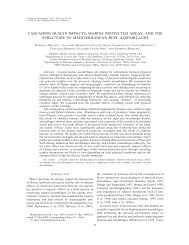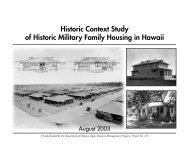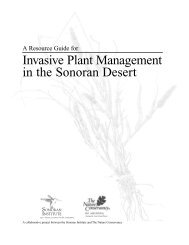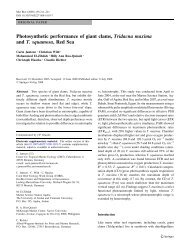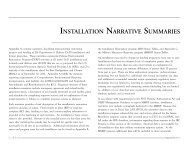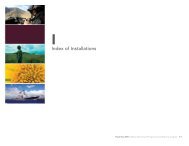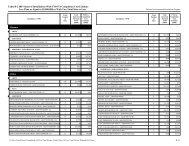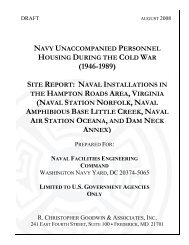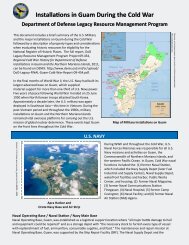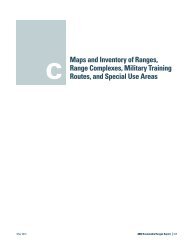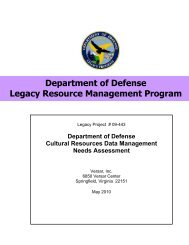Appendix M: Installation Narrative Summaries - denix
Appendix M: Installation Narrative Summaries - denix
Appendix M: Installation Narrative Summaries - denix
Create successful ePaper yourself
Turn your PDF publications into a flip-book with our unique Google optimized e-Paper software.
e��2p���2€�—��2x�F2RR x€v<br />
2ppshX<br />
2ƒ���X<br />
2w������X<br />
2r‚ƒ2ƒ���X<br />
2seq2ƒ�—���X<br />
2g���—���—���X<br />
2w���—2e������X<br />
€�������2„�2h—��<br />
Air Force Plant No. 44 (AFP 44), located adjacent to Tucson<br />
International Airport, was constructed in 1951 to manufacture<br />
Falcon air-to-air missiles. Over the years, industrial facilities<br />
were constructed to support several other missile systems. EPA<br />
placed the entire Tucson International Airport Area, including<br />
AFP 44, on the NPL in 1983. Contaminants identified at the<br />
installation include solvents, machine coolants and lubricants,<br />
paint sludges and thinners, and heavy metals. The installation<br />
formed a Restoration Advisory Board, which was later<br />
converted to a Unified Community Advisory Board (UCAB). The<br />
installation conducted a 5-year review for six soil sites in FY04.<br />
AFP 44 occupies approximately 27.5 acres of the Tucson<br />
International Airport, which totals 1,374 acres. To date, Records<br />
of Decision (RODs) have been signed for three soil vapor<br />
extraction (SVE) sites, three soil excavation sites, and one<br />
groundwater remediation site. A no further action ROD was<br />
signed for four sites. The cleanup progress at AFP 44 for FY02<br />
through FY05 is detailed below.<br />
In FY02, the installation completed the closeout of the Site 2<br />
system and determined that the remaining trace concentrations<br />
of trichloroethylene (TCE) would not adversely affect<br />
groundwater quality. Operation and maintenance (O&M) of the<br />
groundwater reclamation system, SVE systems, and<br />
dual-phase extraction (DPE) systems continued. The<br />
installation analyzed groundwater samples for the presence of<br />
1,4-dioxane. A draft of the 5-year review was completed and<br />
the installation awaited stakeholder comments on the document<br />
before finalizing it. Several actions of the remedial process<br />
optimization Phase III were implemented. The installation<br />
maintained an active role in the joint UCAB that represents<br />
parties responsible for the Tucson International Airport Area<br />
Superfund Site (TIAASS). The Air Force issued an updated<br />
draft community relations plan (CRP), and updated a workshop<br />
and notebook that summarizes information about TIAASS.<br />
In FY03, the installation conducted an expanded in situ pilot<br />
project at Site 2 using potassium permanganate. EPA Region 9<br />
submitted a limited draft risk assessment for 1,4-dioxane. O&M<br />
of the groundwater reclamation system, SVE systems, and<br />
DPE systems continued. The installation submitted the draft<br />
final Site 2 closure report to regulators for review and<br />
Air Force<br />
e WSUIUPRTPWHH<br />
IDQUR2—���<br />
‚���—��D2������D2—��2�—���—����2��������<br />
SUFVTY2��—��2��2x€v2��2IWVQ<br />
x�����—�����2������—�<br />
w—����2���—���D2�—����2��˜��—���D2�—���2�������D2�—���2<br />
��������D2��—��2���—��D2��������<br />
q������—���2—��2����<br />
2p������2��2h—��X<br />
62USFT2�������<br />
2i��F2g„g2@g���2‰�—�AX 62RQFW2�������@p‰2PHQHA<br />
2s‚€Gww‚€2ƒ����2p��—�2‚s€G‚gX p‰2PHHWGx���<br />
2p���E‰�—�2‚�����2ƒ�—���X g��������<br />
concurrence. Comments were received from the regulators on<br />
the draft final 5-year review, which was under revision.<br />
In FY04, AFP 44 conducted an expanded in situ pilot project at<br />
Site 3 and submitted a work plan. The installation also<br />
completed the SVE at Sites 3 and 5 and monitored soil gas for<br />
1 year. In addition, the installation completed the 1,4-dioxane<br />
risk assessment and determined the necessary future actions.<br />
The Air Force submitted the findings to regulators and is<br />
awaiting comments. AFP 44 continued O&M of the groundwater<br />
reclamation system, SVE systems, and DPE systems. The<br />
installation continued the Site 2 in situ pilot, resulting in most of<br />
the Site 2 wells being below drinking water standards.<br />
Regulators approved the Site 2 closure report. Sites 3 and 5<br />
were shut off and soil gas will be monitored to verify that the act<br />
of removing contamination in the vadose posed no threat to the<br />
groundwater. AFP 44 completed the 5-year review for six soil<br />
sites. The installation updated and finalized the AFP 44 CRP.<br />
In FY05, AFP 44 completed the Site 3 permanganate injection<br />
and future monitoring results will determine the effectiveness of<br />
the permanganate injections. The installation conducted soil<br />
gas monitoring for Sites 3 and 5. The results indicate most of<br />
the wells are non-detect. AFP 44 continued O&M of<br />
groundwater reclamation system and the DPE was eliminated<br />
because the source areas have been addressed. The Air Force<br />
updated its Military Munitions Response Program (MMRP)<br />
inventory. No MMRP sites were identified at this installation<br />
during the inventory development.<br />
p‰HT2s‚€2€�������<br />
AFP 44 submitted the closure documents for Sites 3 and 5.<br />
The Air Force is updating the documents based on comments<br />
from EPA Region 9 and the Arizona Department of<br />
Environmental Quality. Additionallly, the Air Force reinjected<br />
more permanganate at Sites 2 and 3 because of the rebound of<br />
TCE concentrations in the monitoring wells. The Air Force is<br />
using soybean and lactic acid to clean up the chromium and<br />
TCE source areas that migrated from Solid Waste Management<br />
Unit D (SWMU D), the former chromium plating area in Building<br />
801. The installation continued O&M of the groundwater<br />
reclamation system. The cost of completing environmental<br />
restoration has changed significantly due to technical issues.<br />
Regulatory issues delayed completion of the closure reports for<br />
Sites 3 and 5.<br />
p‰HT2ww‚€2€�������<br />
The Air Force has identified no MMRP sites at this installation.<br />
€�—�2��2e����<br />
Plan of action items for Air Force Plant No. 44 are grouped<br />
below according to program category.<br />
22222s‚€<br />
0 Complete the closure reports for Sites 3 and<br />
5 in FY07.<br />
0 Reduce the mass of source areas for Sites 2<br />
and 3 by permanganate injection in FY07.<br />
0 Continue cleanup of the chromium and TCE<br />
plume underneath Building 801 which is<br />
migrating from SWMU D in FY07.<br />
0 Continue O&M of the groundwater reclamation<br />
system in FY07.<br />
22222ww‚€<br />
There are no MMRP actions scheduled for FY07 or<br />
FY08.<br />
„����D2e�����—<br />
M-13




